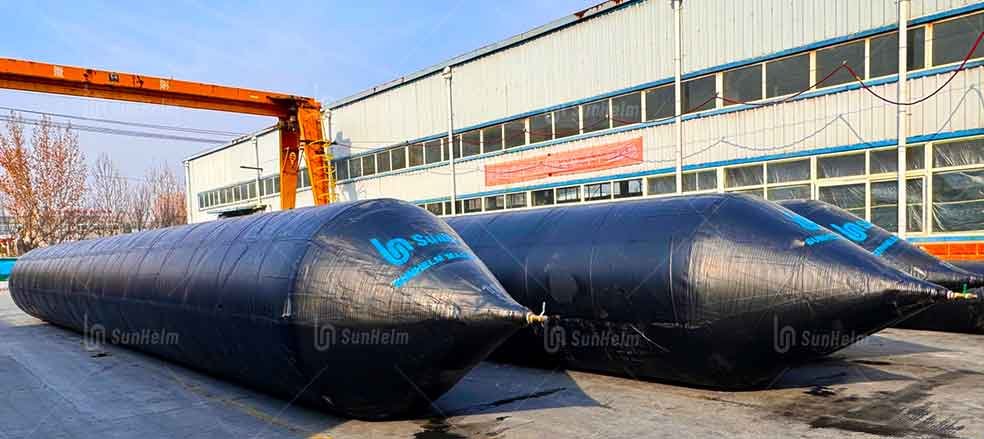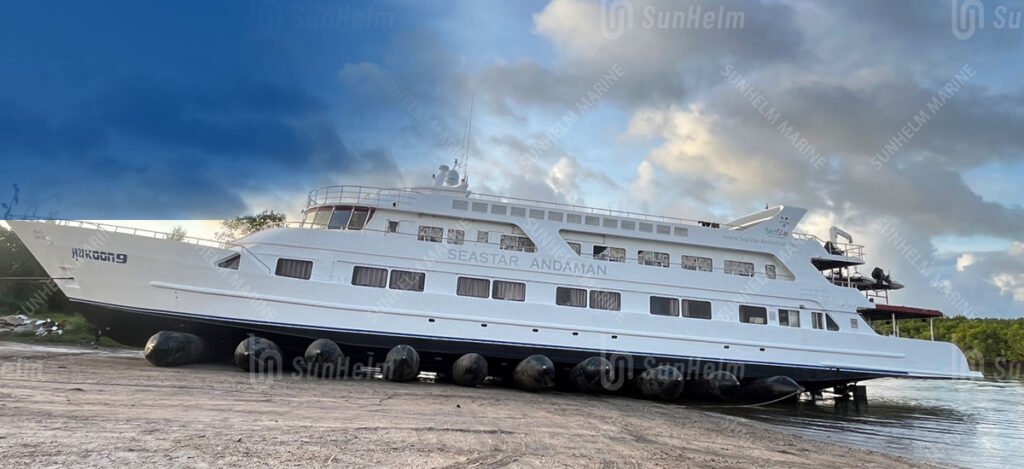Launching a ship is a critical stage in vessel construction or repair, and using ship launching airbags has become a popular, safe, and cost-effective alternative to traditional methods. Whether you’re working with steel, aluminum, or even wooden hulls, marine airbags allow for smooth, controlled launches while minimizing infrastructure costs. In this guide, we’ll walk you through everything you need to know about ship launching using airbags, from equipment and planning to step-by-step procedures and safety tips.

What Is Ship Launching Using Airbags?
Ship launching using airbags is a method where inflatable rubber cylinders, known as marine rubber airbags or simply marine airbags, are placed under the hull. These airbags distribute the ship’s weight evenly and allow it to roll safely into the water. Unlike dry-dock launches, this method doesn’t require expensive cradles or specialized slipways, making it ideal for small to medium shipyards and repair facilities.
Benefits include:
- Cost savings on infrastructure
- Portability and reuse of airbags
- Reduced setup time and labor
- Safe launching for multiple vessel types
How Marine Airbags Work
Marine airbags are essentially heavy-duty rubber cylinders reinforced with synthetic fibers. Their strength and flexibility allow them to support the full weight of the ship while rolling along a slipway.
Key components:
- Outer rubber layers: Protect against abrasion and water damage.
- Synthetic-cord reinforcement: Provides structural strength and prevents deformation.
- End fittings and valves: For inflation and secure placement.
During a launch, the ship is gradually transferred from blocks onto the inflated airbags. As the airbags roll along the slipway, they carry the vessel into the water safely.

Suitability and Constraints
Ship launching airbags work for many vessel types, including cargo ships, yachts, and small ferries. However, some conditions must be met:
- Slipway slope: Typically 1:10 to 1:12, but confirm with the manufacturer.
- Ground strength: Ensure the ground can support both the ship and airbags.
- Water depth: Sufficient depth at the water entry point is critical.
- Environmental conditions: Avoid launching in high winds or strong currents.
If conditions are unsuitable, other launching methods may be safer.
Planning the Launch
Proper planning is crucial. Here’s a quick checklist:
- Survey the vessel dimensions, weight, and center of gravity.
- Measure the slipway length, slope, and ground strength.
- Determine the number, diameter, and length of airbags required.
- Plan the inflation sequence and position of airbags under the hull.
- Assign clear roles for the team and establish a communication plan.
- Prepare safety zones around the slipway.
Equipment You’ll Need
To successfully launch a ship with marine airbags, you’ll need:
- Marine rubber airbags: Correct diameter and length based on ship weight.
- Air compressor and hoses: For inflating airbags to working pressure.
- Valves and pressure gauges: Ensure accurate control and safety.
- Winches or towing lines: For controlled vessel movement.
- Slipway prep tools: Steel plates, chocks, and cribbing.
- Personal Protective Equipment (PPE): Helmets, gloves, and safety shoes.
Sizing & Basic Calculations
Correct sizing ensures safety and smooth movement:
- Calculate the total weight of the vessel and divide by the number of airbags.
- Check the maximum bearing capacity of each airbag.
- Consider slipway slope and friction factors.
- Position airbags evenly along the hull to maintain balance.
Always consult the airbag manufacturer’s guidelines and apply safety factors.
Step-by-Step Launch Procedure
Here’s how to launch a ship using ship launching airbags:
- Inspect and test airbags: Check for wear, leaks, and proper inflation.
- Prepare the slipway: Clean, level, and lay steel plates or chafing materials.
- Position the airbags: Place under the hull in calculated positions.
- Pre-inflate airbags: Bring them to working pressure gradually.
- Transfer the vessel: Remove blocks and let the ship rest on airbags.
- Roll into water: Use winches or controlled guidance to move the ship slowly.
- Post-launch inspection: Check airbags, hull, and surrounding equipment.
Safety & Risk Management
Launching a ship with marine airbags involves hazards. Key safety tips:
- Ensure even load distribution to prevent tilting.
- Never exceed recommended air pressure.
- Keep a clear communication channel for commands.
- Prepare emergency stop procedures.
- Inspect airbags and slipway regularly during the process.
Maintenance & Inspection of Marine Rubber Airbags
To extend airbag life:
- Inspect for cracks, wear, and valve function before each use.
- Store in a cool, dry place away from sunlight and chemicals.
- Repair minor damages promptly; replace airbags with serious defects.
- Keep a log of usage cycles for each airbag.
Cost & Scheduling Advantages
Ship launching using airbags saves both time and money:
- Reusable airbags reduce recurring costs.
- Less infrastructure required than traditional dry-dock launches.
- Quick setup allows for faster project completion.
Troubleshooting
- Vessel skewing: Adjust airbag positions and pressures.
- Slow movement: Check slipway lubrication and slope.
- Airbag leaks: Patch small leaks or replace airbags if necessary.
Case Snapshot
Example: A 25-meter cargo vessel (displacement 120 tons) launched using 12 marine rubber airbags along a 50-meter slipway. Launch was completed safely in 2 hours with no hull damage.
FAQs
Q: Can marine airbags launch steel, aluminum, or wooden boats?
A: Yes, they are suitable for all common hull materials when sized correctly.
Q: How many airbags are needed?
A: Depends on ship weight, hull length, and airbag diameter. Consult manufacturer tables.
Q: Are repaired marine rubber airbags safe?
A: Minor repairs are acceptable if manufacturer guidelines are followed. Always inspect before reuse.
Conclusion
Ship launching using airbags is a safe, flexible, and cost-effective way to launch vessels of various sizes. By carefully planning, selecting the right marine airbags, and following safety protocols, shipyards can achieve smooth, controlled launches with minimal risk and expense.


